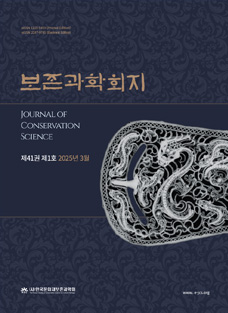Journal of Conservation Science Vol.29 No.4 pp.297-309
보존처리 후 철제유물에 생성된 부식물 특성 연구
Study on Characteristics of Corrosion Products Generated in Iron Artifacts after Conservation Treatments
Ji-Hae Jeong,Hee-Jae Yang,Jin-Uk Ha
Abstract
Iron objects become corroded at fast speed from the moment when they are excavated, so it is needed to control corrosion through processes of conservation treatment. However, re-corrosion mostly takes place in excavate iron objects, although they have already gone through the process of conservation treatment, and it is more difficult to carry out the second conservation treatment of re-corroded excavated iron objects than the first conservation treatment, and it requires a longer period of time to treat them as well. In this study, aims to discover factors of re-corrosion by scientifically analyzing corrosion products generated during the process of storage after the process of conservation treatment. The finished on conservation treatment of the iron artifacts, which were unearthed from three ancient site in Gyeongju by using the same conservation method between 2002 and 2009, re-corrosion condition observed on the packaging-iron artifacts. Focused on 9 target forged iron artifacts among them, this study analyzed the physical changes by mass measurement, naked-eye and microscopic observations and the chemical changes by SEM-EDS, XRD, IC and ICP analysis. The results show that the yellowish brown corrosion products formed on the facing surface of part dropped from the artifacts had different associated forms but acicular shape. In addition, the acicular shape became clearer as the color changed from red to yellowish brown. According to the process when the conservation treatment was completed, the mass of the artifacts increased in proportion to the corrosion products and the chloride ion (Cl-) concentration had a tendency to increase relatively. β-FeOOH (akaganeite) was confirmed in the XRD analysis for the corrosion products of all the collected samples. As a result of ICP analysis, Na+ and Ca2+ components were confirmed.

 E-Submission
E-Submission 
 E-Submission
E-Submission 
![]() Journal Search Engine
Journal Search Engine




 KSC
KSC